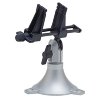Well, almost everything else is simple. Since there has already been a lot of warning about roll pins, it should be mentioned that pivot pin assembly (spring and detent) installation can be VERY frustrating. In fact, if you look on ar15.com at their document about lower receiver building, (link
here), the pivot pin assembly section states, "This is perhaps the hardest part of the lower assembly ..."
They encourage using an installation tool. I have used the tool and have launched springs, so it still can be challenging. I also have installed it flawlessly (even without the tool) and it takes only a few seconds. Just be careful, go slowly, and have a way to catch the spring and detent just in case.
I really enjoy building lowers. Get the right tools, practice by building and un-building several times, take your time, and have fun.



